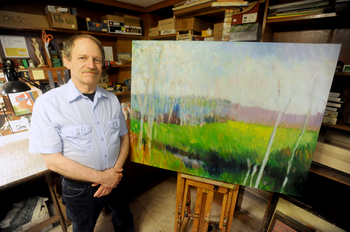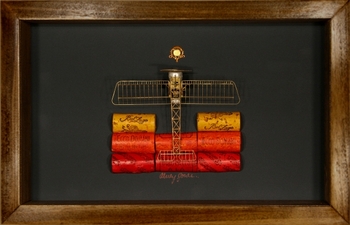Leaving creative channels open with artist Alvey Jones

Artist Alvey Jones stands in his home studio next to a painting in progress on Tuesday.
Angela J. Cesere | AnnArbor.com
Ann Arbor artist Alvey Jones got into drawing and building model airplanes as a youth. He went on to have a long career in commercial illustration and design while simultaneously creating and exhibiting fine artworks along the way. Now, as a retiree from the design world, Jones is a full-time professional fine artist and a member of the WSG Gallery. He creates a diverse range of paintings, collages, assemblages and artist books, and he draws a monthly comic strip, "Bezonki," which appears in the Ann Arbor Chronicle.
When it comes to his artistic process, there are certain things that usually happen. However, there are “always exceptions,” Jones stresses. “The biggest fight that a creative artist has is to keep all of their creative channels open, so that when something happens you are ready to pounce on things like accident, mistakes, failures and things you would never have expected that come your way. Those things are often extremely fruitful for a creative artist,” he says.
Drawing inspiration from all over the place, the artist frequently collects images, quotes and ideas from books, magazines, movies, television, art history and his personal experiences. He takes his sketchbook all over the place — doodling at a museum, in front of the TV or while at the movie theater. He also keeps track of his thoughts by doing a lot of journaling and jotting down quotes “that jog something in my mind,” he says.
Sometimes old sketches, journal entries and other materials he collects over time make their way into new artworks — especially in the case of Jones’ artist books. “The artworks I do generate a lot of stuff. Normally, I throw it in a box and stick it under my drawing board. I don’t keep everything, but I keep a lot. I have a stockpile of images I can use,” when the time is right, he explains.
Jones’ career in art and design began after he studied commercial art and illustration at Bradley University, located in his hometown of Peoria, Illinois. One of his teachers, commercial artist and graphic designer Gerald Fromberg — who was friends with historically-reknown painter Richard Diebenkorn — “also had a foot in the so-called fine arts. He encouraged his students to study not only designers and illustrators, but people like Monet and Giotto — all of the fine art masters. Slowly, I had ambitions to be a painter as well as a commercial artist,” he remembers.
Before landing in Ann Arbor, Jones had a number of commercial illustration and graphic design jobs, studied and taught art history at the graduate level, and continually created fine artworks. His gigs have included working at an art studio in Peoria; working at Gene Autry’s COOL-TV station in Phoenix, Arizona; designing visual training aids for the U.S. Army after getting drafted; working in the Division of Broadcasting at the University of Illinois at Urbana-Champaign; and illustrating for a New York hospital.
After moving to Ann Arbor with his wife, an editor and writer, Jones decided to go back to school one more time, studying computer programming at Washtenaw Community College and working as a software engineer for machine tool manufacturing company Normac in Northville, Michigan until 2001.
Jones says, all along the way, “Parallel with my interest in painting and commercial illustration, I also had an interest in the history of art. I got accustomed to working in different theaters and having all these things cross-fertilize each other.”
Most of the time, “I take a long route from my initial idea to the finished piece,” although his process can happen quickly on occasion, Jones says. His mixed media assemblage "The Poetry of Dust" took about two decades to complete, in the artist’s estimation. The artwork contains a central image of two people drifting along on a boat — accompanied by a series of glass bottles containing colored water, objects and spices from his kitchen cabinet.
Jones recalls sitting beside a lake just north of the University of Wisconsin’s campus, while on vacation with his wife. “It was one of the few times I didn’t have a sketchbook. I didn’t have my camera. I just had this vision of this boat with two people in it. That vision just never left me. I was awestruck by that image and would collect images of people on boats. None of them were ever exactly right on. I couldn’t reproduce that image I had in my head.” he says. Eventually, Jones gathered up all of the sketches and other things that reminded him of his vision in Wisconsin. “I made an amalgam of what I thought (the people on the boat) looked like,” he explains.
A number of Jones’ artworks contain images taken from art history. He says that most of the time he uses these images as “formal elements.” More often than not they are “images that, to me, are formally powerful or aesthetically beautiful,” he explains. Although, “sometimes I’m deliberately making a reference to another artist, it usually starts off with an aesthetic attraction — a personal aesthetic response,” to things like texture, color and the form of an image or object, he says.
For example, Jones’ mixed media assemblage "Logic and Metaphor" features an image of the highly-recognizable statue "Venus de Milo." However, the artist is not referencing the story of Venus or some other story that people attach to the original sculpture. Rather, he uses the image more like a brushstroke — just another aesthetic element that gives the work its formal characteristics.

"Dawn Patrol" brass, plastic, acrylic on corks assemblage by Alvey Jones, on view at WSG Gallery through June 27, 2010.
But there are always exceptions. In some cases, he makes direct references to other artists, history, and ideas taken from literature and other sources, which go beyond the formal qualities of the artworks — suggesting things like metaphor, allegory, and narrative. Sometimes you can find hints in his titles, as in his assemblage "Hegel in New York" or his "Disturbing the Universe" series of abstract paintings, a title inspired by a line in T.S. Eliot’s “Love Song of J Alfred Prufrock” that was used as a book title by physicist Freeman John Dyson. He says the paintings depict the way “abstract painting disturbs my own universe,” in a good way, when he has a case of artist’s block.
Jones presented himself with a unique challenge to create his monthly cartoon, "Bezonki." “The goal was to draw a cartoon with no text,” he says. “They aren’t one-liners or puns. Each panel has a substance, background, and a texture that is personal to me. It’s like when someone comes to a gallery to see your painting. They bring their own background to it and they are liable to interpret it in ways that you’ve never thought of,” he says.
WSG Gallery presents solo exhibitions of new work by all of their member artists on a rotating schedule; Alvey Jones will be up to bat in September and October of 2010.
Jennifer Eberbach is a free-lance writer who covers art for AnnArbor.com.

